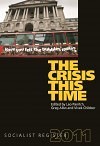Can’t You See It Coming?
Fires crackle in the brittle trees
bled dry by drought, the grass,
bleached straw on the dusty hills
where rain no longer falls
in what used to be its season | more…
Fires crackle in the brittle trees
bled dry by drought, the grass,
bleached straw on the dusty hills
where rain no longer falls
in what used to be its season | more…

In his new extensively revised and expanded edition of this book, Samir Amin suggests new approaches to Marxian analysis of the crisis of the late capitalist system of generalized, financialized and globalized oligopolies following on the financial collapse of 2008. Considering that Marx’s Capital, written before the emergence of imperialism as a decisive factor in capitalist accumulation, could provide no explanation for the persistent “underdevelopment” of the countries of the “global South,” Amin advances several important theoretical concepts extending traditional Marxian views of capitalist evolution. | more…

The global economic crisis that closed the first decade of the 21st century has demonstrated that the contradictions of capitalism cannot be overcome. The challenge for socialist analysis is to reveal both the nature of these contradictions in the neo-liberal era of globalized finance, and their consequences in our time. Crises need to be understood as turning points that open up opportunities. How to facilitate this is the sharpest challenge posed to socialists by the most severe global economic crisis since the 1930s. | more…
In a series of articles in Monthly Review and in Monthly Review Press books during the 1970s and 1980s, Harry Magdoff and Paul Sweezy proposed that the general economic tendency of mature capitalism is toward stagnation. A shortage of profitable investment opportunities is the primary cause of this tendency. Less investment in the productive economy (the “real economy”) means lower future growth. Marx wrote about the possibility of this very phenomenon | more…
“The law is a mask that the state puts on when it wants to commit some indecency upon the oppressed.” I put these words into the mouth of a character in my play “Haymarket: Whose Name the Few Still Say with Tears.” Jean-Claude Paye has once again done us a service by showing how those words can come true. In theory, the bourgeois democratic state, as defined in the American constitution, was to operate under two basic principles. The first of these was separation of powers. Legislative and executive action would be held to a standard of legality by the action of unelected and therefore presumably independent judges. The second principle, elaborated more fully in the Bill of Rights, is that certain invasions of individual personal liberty are forbidden, and that the judges will provide a remedy against those who commit such invasions | more…
The function of criminal law has been altered within the context of the anti-terrorist struggle. Normally, criminal law treats prosecuted persons as individuals. The criminalization of terrorist organizations and the criminalization of participation in or support for such organizations create offenses of collective responsibility. The object is to attack actual or potential organizations. It is no longer just the act of committing a crime or even the intention of doing so that is prosecuted. Merely belonging to a group that is considered terrorist by the government is sufficient for punishment | more…
“I feel like a bad person.”
“I feel like a snail without a shell whose heart has been stepped on.”
These feelings were jotted down in Spanish by my second graders during the four weeks of standardized tests required by the No Child Left Behind Act (NCLB). The educational policy was instituted on the heels of the September 11 attacks by President George Bush, backed by both Democrats and Republicans. My students are required to take tests in Standard English, though half have yet to make the transition from Spanish to a second language in my immersion classroom | more…
Margot Pepper And Her 2005 Second Grade Class At Rosa Parks Elementary School In Berkeley, California | more…
Fidel Castro’s illness in August has nurtured the hopes of Miami-based Cuban émigrés and the U.S. ruling class that a “transition in Cuba” will soon be possible. It is often implied that this is a question of a transition to “democracy” and “free elections.” However, what is actually being planned in Washington, as part of a decades-long strategy, is an immediate transition back to capitalism in Cuba—at whatever the cost to the Cuban people | more…
Harry died in the early hours of January 1, 2006, at our house in Burlington, Vermont, where he had lived for three and a half years. As he died, I laid on the big double bed facing him and held his arms, with my wife, his caregiver, and his good friends Gladys and Percy Brazil there too. Talking with them after he died I reflected on how it had been an honor to have Harry live with Amy and me since my mother Beadie had died and to help him get the most out of his final years. It was also fun and intellectually stimulating, although sometimes a challenge because of my health problems and our work schedules | more…
The following intellectual biography of Harry Magdoff is a slightly revised and expanded version of a piece that was posted on MRzine a few days after Harry’s death on January 1, 2006. It evolved out of an earlier biography I wrote for the Biographical Dictionary of Dissenting Economists in 2000. Since the aim of this biography was to present the basic facts of Harry’s intellectual career, personal feelings and observations were largely excluded. A brief word on Harry’s character and the warm emotions he engendered within those who knew him therefore seems essential here | more…
Harry Magdoff died on New Year’s Day 2006 at the age of ninety-two. He will be remembered in the hearts of those who knew him, those who were profoundly influenced when they heard him speak, and those who have read Monthly Review and his great books on imperialism, which helped mature the thinking of the generation of leftists who came of age during the Vietnam War. It is the warmth of his person, the clarity and incisiveness of his thinking, and his profound vision of the absolute necessity of socialism that characterize his historic contributions and set him apart as one of a handful of great Marxist thinkers of the last century. The breadth of Harry’s knowledge—his grasp of world history, Marxist literature, and broader literatures—was extraordinary. He was as content, for example, to discuss the nature of calculus with a college student as Shakespeare with a Shakespeare scholar, all with that wonderful enthusiasm and energy he always brought to conversations | more…
Notifications